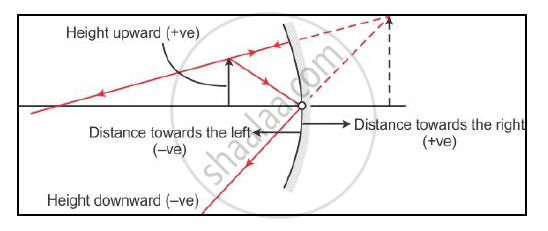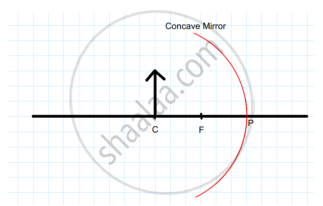Advertisements
Advertisements
प्रश्न
With the help of an appropriate ray diagram, state the sign conventions for reflection by a spherical mirror.
उत्तर
The sign convention for reflection by spherical mirrors is as follows:-

- The object is always placed to the left of the mirror.
- All distances parallel to the principal axis are measured from the pole of the mirror.
- All the distances measured to the right of the origin are taken as positive, while those measured to the left of the origin are taken as negative.
- Distances measured perpendicular to and above the principal axis are taken as positive.
- Distances measured perpendicular to and below the principal axis are taken as negative.
- The focal length of a convex mirror is positive, while that of a concave mirror is negative.
APPEARS IN
संबंधित प्रश्न
It is desired to obtain an erect image of an object, using concave mirror of focal length of 12 cm.
Where will the image of this object be, if it is placed 24 cm in front of the mirror? Draw ray diagram for this situation also justify your answer. Show the positions of pole, principal focus and the centre of curvature in the above ray diagrams
To determine the approximate value of the focal length of a given concave mirror, you focus the image of a distant object formed by the mirror on a screen. The image obtained on the serene, as compared to the object is always:
(a) Laterally inverted and diminished
(b) Inverted and diminished
(c) Erect and diminished
(d) Erect and highly diminished
Draw the following diagram in which a ray of light is incident on a concave/convex mirror on your answer sheet. Show the path of this ray, after reflection, in each case.

A student has obtained the image of a distant object with a concave mirror to determine its focal length. If he has selected a well-illuminated red building as object, which of the following correctly describes the features of the image formed?
(A) Virtual, inverted and diminished image in red shade
(B) Real, erect and diminished image in pink shade
(C) Real, inverted and diminished image in red shade
(D) Virtual, erect and enlarged image in red shade
A spherical mirror produces an image of magnification −1 on a screen placed at a distance of 40 cm from the mirror:
(i) Write the type of mirror.
(ii) What is the nature of the image formed?
(iii) How far is the object located from the mirror?
(iv) Draw the ray diagram to show the image formation in this case.
The image of a candle flame placed at a distance of 30 cm from a mirror is formed on a screen placed in front of the mirror at a distance of 60 cm from its pole. What is the nature of the mirror? Find its focal length. If the height of the flame is 2.4 cm, find the height of its image. State whether the image formed is erect or inverted
Which type of mirror is used by a dentist?
If the focal length of a convex mirror is 25 cm, what is its radius of curvature?
Define (i) principal focus of a concave mirror, and (ii) focal length of a concave mirror.
Copy this figure in your answer book and show the direction of the light ray after reflection:
Which mirror is used as a torch reflector? Draw a labelled diagram to show how a torch reflector can be used to produce a parallel beam of light. Where is the bulb placed in relation to the torch reflector?
A concave mirror has a focal length of 25 cm. At which of the following distance should a person hold his face from this concave mirror so that it may act as a shaving mirror?
(a) 45 cm
(b) 20 cm
(c) 25 cm
(d) 30 cm
Give reason for your choice.
According to the "New Cartesian Singh Convention" for mirrors, what sign has been given to the focal length of:
a concave mirror?
What kind of mirror can have a focal length of, −20 cm?
One of the following does not apply to a concave mirror this is:
(a) focal length is negative
(b) image distance can be positive or negative
(c) image distance is always positive
(d) height of image can be positive or negative
A large concave mirror has a radius of curvature of 1.5 m. A person stands 10 m in front of the mirror. Where is the person's image?
An object of 5.0 cm size is placed at a distance of 20.0 cm from a converging mirror of focal length 15.0 cm. At what distance from the mirror should a screen be placed to get the sharp image? Also calculate the size of the image.
A concave mirror produces three times enlarged virtual image of an object placed at 10 cm in front of it. Calculate the radius of curvature of the mirror.
A concave mirror produces a real image 1 cm tall of an object 2.5 mm tall placed 5 cm from the mirror. Find the position of the image and the focal length of the mirror.
At what distance from a concave mirror of focal length 10 cm should an object be placed so that:
its real image is formed 20 cm from the mirror?
If a concave mirror has a focal length of 10 cm, find the two positions where an object can be placed to give, in each case, an image twice the height of the object.
If the image formed is always virtual, the mirror can be:
(a) concave or convex
(b) concave or plane
(c) convex or plane
(d) only convex
The mirror which can form a magnified image of an object is:
(a) convex mirror
(b) plane mirror
(c) concave mirror
(d) both convex and concave mirror
An object is placed 15 cm from (a) a converging mirror, and (b) a diverging mirror, of radius of curvature 20 cm. Calculate the image position and magnification in each case.
Draw a ray diagram to show the formation of image of an object placed on the principal axis of a convex mirror. State the position, size and nature of the image. What happens to the image as the object is moved away from the mirror?
Suppose you have three concave mirrors A, B and C of focal lengths 10 cm, 15 cm and 20 cm. For each concave mirror you perform the experiment of image formation for three values of object distance of 10 cm, 20 cm and 30 cm. Giving reason answer the following:
(a) For the three object distances, identify the mirror/mirrors which will form an image of magnification – 1.
(b) Out of the three mirrors identify the mirror which would be preferred to be used for shaving purposes/makeup.
(c) For the mirror B draw ray diagram for image formation for object distances 10 cm and 20 cm.
A student has focused the image of a candle flame on a white screen using a concave mirror. The situation is as given below:
Length of the flame = 1.5 cm
Distance of flame from the mirror = 18 cm
If the flame is perpendicular to the principal axis of the mirror, then calculate the following:
- Distance of the image from the mirror
- Length of the image
If the distance between the mirror and the flame is reduced to 10 cm, then what would be observed on the screen? Draw ray diagram to justify your answer for this situation.
To construct ray diagram we use two light rays which are so chosen that it is easy to know their directions after reflection from the mirror. List these two rays and state the path of these rays after reflection. Use these rays to locate the image of an object placed between centre of curvature and focus of a concave mirror.
Draw the ray diagram and also state the position, the relative size and the nature of image formed by a concave mirror when the object is placed at the centre of curvature of the mirror.
A student has to trace the path of a ray of light passing through a rectangular glass slab for four different values of angle of incidence.
(a) Write two important precautions for this experiment.
(b) List two conclusions the student will draw based on his experiment.
State whether true or false. If false, correct the statement.
When an object is at the centre of curvature of concave mirror the image formed will be virtual and erect.
Large ______ mirrors are used to concentrate sunlight to produce heat in solar furnaces.
A concave mirror of radius 30 cm is placed in water. It’s focal length in air and water differ by ______.

Examine the above figure and state which of the following option is correct? [one small box in the figure is equal to 1 cm]
Rays from Sun converge at a point 15 cm in front of a concave mirror. Where should an object be placed so that size of its image is equal to the size of the object?
The ENT doctor uses a ______.
In the headlights of motor vehicles, ______ mirrors are used as reflectors.
______ mirrors make things look larger when objects are placed close to them.
